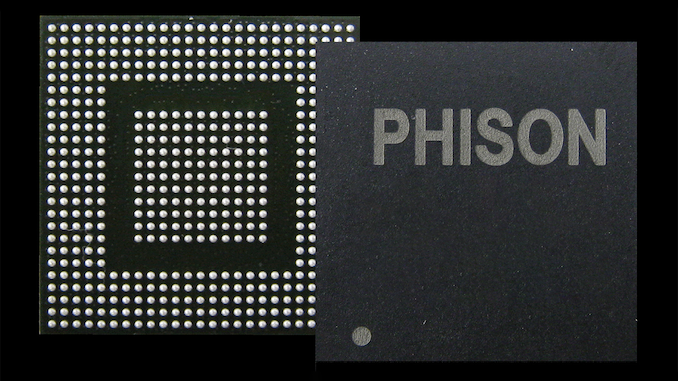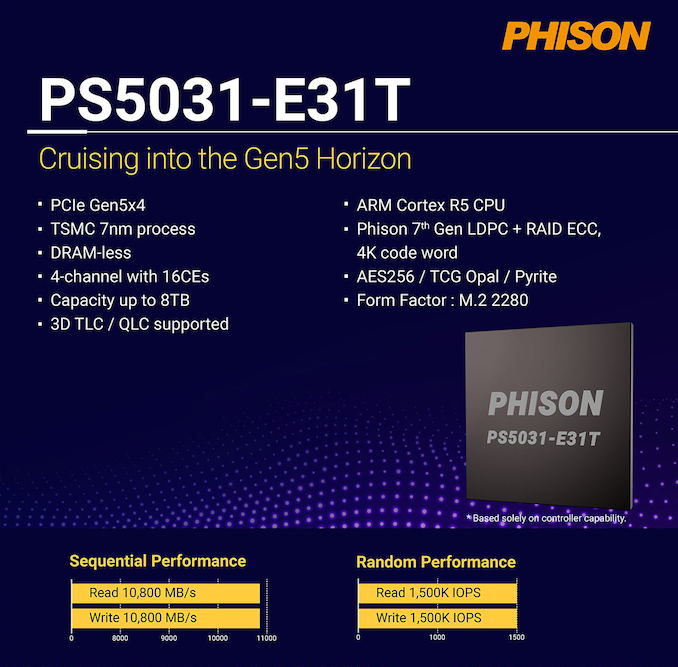Phison Unveils PS5031-E31T SSD Platform For Lower-Power Mainstream PCIe 5 SSDs
by Anton Shilov on May 29, 2023 6:00 PM EST- Posted in
- Storage
- SSDs
- Phison
- Computex 2023
- PS5031-E31T

At Computex 2023, Phison is introducing a new, lower-cost SSD controller for building mainstream PCIe 5.0 SSDs. The Phison PS5031-E31T is a quad channel, DRAM-less controller for solid-state drives that is designed to offer sequential read/write speeds up to 10,8 GB/s at drive capacities of up to 8 TB, which is in line with some of the fastest PCIe 5.0 SSDs available today.
The Phison E31T controller is, at a high level, the lower-cost counterpart to Phison's current high-end PCIe 5.0 SSD controller, the E26. The E31T is based around multiple Arm Cortex R5 cores for realtime operations, and in Phison designs these are traditionally accompanied by special-purpose accelerators that belong to the company's CoXProcessor package. The chip supports Phison's 7th Generation LDPC engine with RAID ECC and 4K code word to handle the latest and upcoming 3D TLC and 3D QLC types of 3D NAND. The controller also supports AES-256, TCG Opal, and TCG Pyrite security.
The SSD controller is organized in four NAND channels with 16 chip enable lines (CEs) each, allowing it to address 16 NAND dies per channel. For now Phison is refraining from disclosing NAND interface speeds the controller supports, though given the fact that the controller is set to support sequential read/write throughput of 10,800 MB/s over four channels, napkin math indicates they'll need to support transfer rates of at least 2700 MT/s. This is on the upper-end of current ONFi/Toggle standards, but still readily attained. For example, Kioxia's and Western Digital's latest 218-layer BICS 3D NAND devices support a 3200 MT/s interface speed (which provides a peak sequential read/write speed of 400 MB/s).
Phison says that its E31T controller will enable M.2-2280 SSDs with a PCIe 5.0 x4 interface and a capacities of up to 8 TB. Phison's DRAM-less controllers tend to remain in use in SSD designs for quite a while due to their mainstream posiitoning and relatively cheap price, so, unsurprisingly, Phison traditionally opts to plan for the long term with regards to capacity. 8 TB SSDs will eventually come down in price, even if they aren't here quite yet.
| Phison NVMe SSD Controller Comparison | |||||||||
| E31T | E27T | E21T | E26 | E18 | |||||
| Market Segment | Mainstream Consumer | High-End Consumer | |||||||
| Manufacturing Process |
7nm | 12nm | 12nm | 12nm | 12nm | ||||
| CPU Cores | 1x Cortex R5 | 1x Cortex R5 | 1x Cortex R5 | 2x Cortex R5 | 3x Cortex R5 | ||||
| Error Correction | 7th Gen LDPC | 5th Gen LDPC | 4th Gen LDPC | 5th Gen LDPC | 4th Gen LDPC | ||||
| DRAM | No | No | No | DDR4, LPDDR4 | DDR4 | ||||
| Host Interface | PCIe 5.0 x4 | PCIe 4.0 x4 | PCIe 4.0 x4 | PCIe 5.0 x4 | PCIe 4.0 x4 | ||||
| NVMe Version | NVMe 2.0? | NVMe 2.0? | NVMe 1.4 | NVMe 2.0 | NVMe 1.4 | ||||
| NAND Channels, Interface Speed | 4 ch, 3200 MT/s? |
4 ch, 2400 MT/s? |
4 ch, 1600 MT/s |
8 ch, 2400 MT/s |
8 ch, 1600 MT/s |
||||
| Max Capacity | 8 TB | 8 TB | 4 TB | 8 TB | 8 TB | ||||
| Sequential Read | 10.8 GB/s | 7.4 GB/s | 5.0 GB/s | 14 GB/s | 7.4 GB/s | ||||
| Sequential Write | 10.8 GB/s | 6.7 GB/s | 4.5 GB/s | 11.8 GB/s | 7.0 GB/s | ||||
| 4KB Random Read IOPS | 1500k | 1200k | 780k | 1500k | 1000k | ||||
| 4KB Random Write IOPS | 1500k | 1200k | 800k | 2000k | 1000k | ||||
Compared to the high-end E26 controller, the E31T supports fewer NAND channels and NAND dies overall, but enthusiasts will also want to take note of the manufacturing process Phison is using for the controller. Phison is scheduled to build the E31T on TSMC's 7nm process, which although is no longer-cutting edge, is a full generation ahead of the 12nm process used for the E26. So combined with the reduced complexity of the controller, this should bode well for cooler running and less power-hungry PCIe 5.0 SSDs.
The smaller, mainstream-focused chip should also allow for those PCIe 5.0 SSDs to be cheaper. Though, as always, it should be noted that Phison doesn't publicly talk about controller pricing, let alone control what their customers (SSD vendors) charge for their finished drives.
As for availability of drives based on Phison's new controller, as Phison has not yet announced an expected sampling date, you shouldn't expect to see E31T drives for a while. Phison typically announces new controllers fairly early in the SSD development process, so there's usually at least a several month gap before finished SSDs hit the market. Case in point: drives based on Phison's PCIe 4.0 E27T controller, which was announced at Computex 2022, are still not available. Otherwise, as Phison's second PCIe 5.0 controller, the E31T should hopefully encounter fewer teething issues than the initial E26, but we'd still expect E31T drives to be 2024 products.
Source: Phison











10 Comments
View All Comments
meacupla - Monday, May 29, 2023 - link
Wow, those theoretical maximums are fast for something that is "low power" and "mainstream".I am correct in assuming the bottleneck for this controller will be at the NAND being unable to keep up with it?
Eliadbu - Tuesday, May 30, 2023 - link
Depends on the task, on the configuration and the NAND.Small Bison - Tuesday, May 30, 2023 - link
Do the sixteen chip enable lines mean that it would need 4 Tb dies to reach 8 TB?ZeroVelocity - Tuesday, May 30, 2023 - link
No, it's per channel, so only 1Tbit dies.nandnandnand - Tuesday, May 30, 2023 - link
More DRAM-less QLC SSDs, yay.Silver5urfer - Tuesday, May 30, 2023 - link
Phison is not used in Enterprise from what I recall. Also M.2 SSDs from my research very unstable.Samsung 980 and 990 Pro lines both of them have Firmware problems and still have lingering issues, sth forum has it mentioned. The BICS5 flash is also kind of similar. Then you have Seagate Firecuda which has top notch endurance going up in bsod and dying, many reviews on Amzn mention that, happens on PS5 installs too, they all die after a year, not sure if a batch is the issue or not. Sabrent uses Phison, I do not think they are rock solid either. Then you have WD 850 series which still have firmware problems, wd official forum has it all a big thread.
They simply do not have M.2 2280 in Enterprise, I always try to mention this here because people should know, if you look up any SATA 6 GBs standard SSDs for Data Center you have Samsung PM line, Kingstons DC line and Micron has them too. All of them have extreme endurance ratings to the north of 7000TBW+ using TLC. Now you may wonder how and why, that's how Enterprise rolls. Also U.2 SSDs have similar numbers and superior designs, the heat factor is not a thing because they have massive PCB area and the housing is full metal and can work wonders.
Now we do not have 4.0 saturated enough and moving to 5.0 the sheer stupidity is the active cooling, all for that 14000MBs data rate but IRL the sustained performance once the pseudo SLC cache wares off the whole thing halts like a rock and drops speed. They drop to 800MBs-1500MBs and only few can cross that upto 2000MBs. It's really a joke how we have this market, with 5.0 you get insanely worst looking active coolers for the sub standard useless performance.
Samus - Tuesday, May 30, 2023 - link
Our entire datacenter of supermicro gen 10-gen12 chassis have M2 2280 and M2 22110 SSD's. Thousands of them, majority Toshiba and Samsung, most 960GB-1.92GB and many years old. 0 failures.Silver5urfer - Tuesday, May 30, 2023 - link
22110 is Enterprise class but I do not see much of 2280 class M.2 drives used with higher capacity than Consumer storage.dotjaz - Thursday, August 10, 2023 - link
>22110 is Enterprise classSo? Is it not still M.2?
Chris_Ramseyer - Tuesday, May 30, 2023 - link
...other than having the fastest enterprise controller on the market today with E20. Seagate has the exclusive rights to it. Over 7,400 MB/s seq read and 1.75M random read IOPS (4K).E18 can sustain over 3,000MB/s seq write BTW post pSLC cache.
Your post has a lot of outdated info.